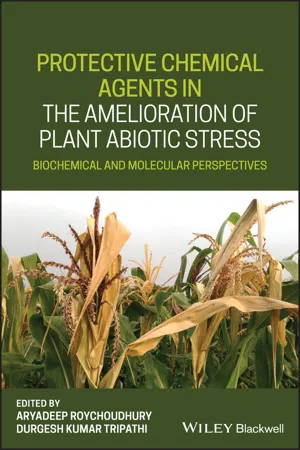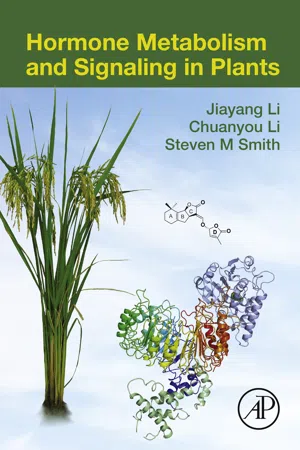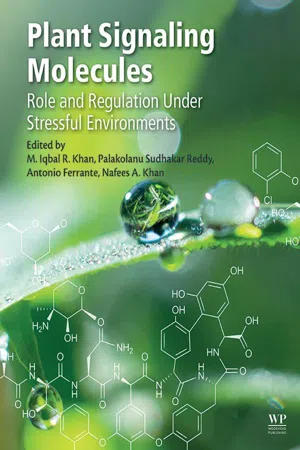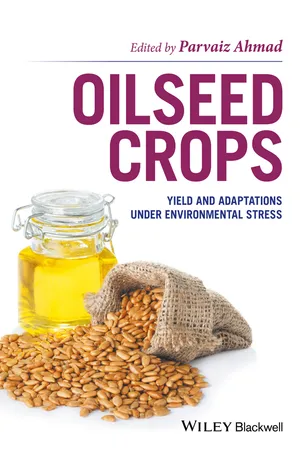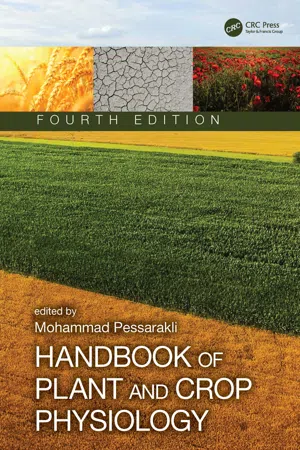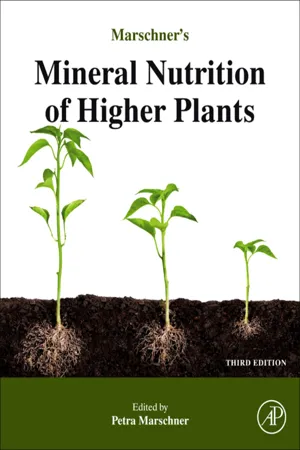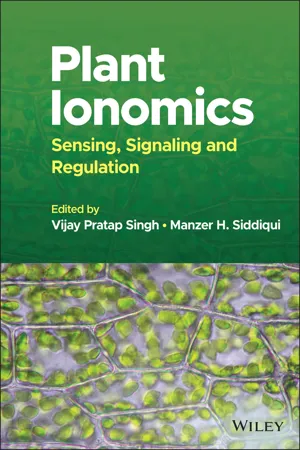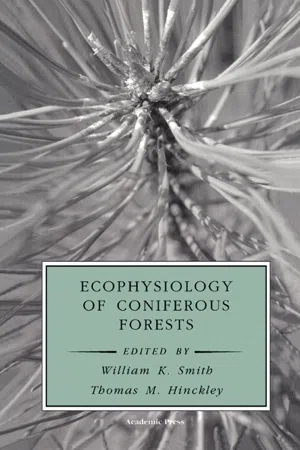Biological Sciences
Plant Hormones
Plant hormones are chemical messengers produced by plants to regulate growth, development, and responses to environmental stimuli. They play a crucial role in controlling processes such as seed germination, root and shoot growth, flowering, and fruit ripening. The main classes of plant hormones include auxins, gibberellins, cytokinins, abscisic acid, and ethylene.
Written by Perlego with AI-assistance
Related key terms
Related key terms
1 of 4
Related key terms
1 of 3
12 Key excerpts on "Plant Hormones"
- eBook - ePub
Protective Chemical Agents in the Amelioration of Plant Abiotic Stress
Biochemical and Molecular Perspectives
- Aryadeep Roychoudhury, Durgesh K. Tripathi, Aryadeep Roychoudhury, Durgesh Kumar Tripathi(Authors)
- 2020(Publication Date)
- Wiley-Blackwell(Publisher)
2005 ).The major advancement achieved in the area of phytohormones and their respective response is the identification of precise receptor for majorly known hormones. These chemical messengers are translocated to several organelles where they bind to their target site via receptor‐mediated recognition and further transduce the signal downstream by themselves getting degraded. Thus, ordered degradation of protein also plays a pivotal role in hormone signaling, which is regulated mainly by ubiquitin‐mediated degradation (Santner et al. 2009 ). Several synergistic or antagonistic actions take place simultaneously, which are primarily key to regulation of defense mechanism in plants against variety of stresses, and termed as signaling cross talk. In the recent research, efforts have been laid down to reveal the complex physiological and molecular responses of stress tolerance, however the molecular intricacy still remains ambiguous. The major problem lies in the complex nature of plant response for different situations, as both biotic as well as abiotic stresses are known to express extreme yet similar suites of genes. A common factor for both types of stress is said to be the generation of small molecules, which, if not regulated, are known to be highly toxic at higher concentration and are termed as active or reactive oxygen species (ROS ). The generation and simultaneous scavenging of ROS holds a key step involved in response to biotic and abiotic stresses (Apel and Hirt 2004 ). Using large scale transcriptome and microarray analysis, it is evident that similar cross talk exists between these signaling networks (Seki et al. 2002 ; Cheong et al. 2002 ; Davletova et al. 2005 ). The evidence that ROS may act as a common downstream messenger for transducing multiple stress signals was established in plants challenged either with heavy metal or with necrotrophic pathogen where a similar increase in ROS levels was monitored. The study demonstrated a similar yet overlapping set of responses in all plants challenged with either type of stress. Apart from their role in growth enhancement, an improved plant growth and yield was observed through exogenous application of phytohormones. In a study, Li et al. (2012 ) reported an increased photosynthetic activity, enhanced nitrogen metabolism, and improved generation of amino acid through application of brassinosteroid hormones in Camellia sinensis. The authors further reported an improved hormone metabolism as well as better antioxidant system in maize seedlings primed with exogenous salicylic acid and H2 O2 , thus helping maize seed to mitigate deleterious effects of chilling stress. Recent study conducted by Singh et al. (2017 - eBook - ePub
- Wenhao Dai, Wenhao Dai(Authors)
- 2019(Publication Date)
- CRC Press(Publisher)
Plant Hormones and environmental factors play central roles in the regulation of growth, development, nutrient allocation, and source/sink transitions. Plant Hormones play important functions in regulating developmental processes and signaling networks involved in plant responses to a wide range of biotic and abiotic stresses. The response and adaptation of plants are determined by complex interactions with metabolites, plant growth regulators (PGRs), secondary messengers, and downstream defense and/or homeostasis genes. Plants produce a wide variety of hormones that include abscisic acid (ABA), auxins, brassinosteroids, cytokinins, ethylene, gibberellins, jasmonic acid (JA), methyl jasmonate (MeJA), and salicylic acid (SA). Apart from the PGRs, vital environmental cues, such as light and temperature, also entrain several physiological processes in plants. Hence, in this chapter, the various roles of environmental factors and Plant Hormones in the regulation of plant growth and development are discussed.4.2 Plant Hormones and Plant Growth Regulators (PGRs)
Plant Hormones are small molecules that regulate plant growth and development, as well as responses to changing environmental conditions (Colebrook et al., 2014). Plant development is regulated and coordinated through the action of several classes of small molecules (Plant Hormones) that may act either close to or remote from their sites of synthesis to mediate genetically programmed developmental changes or responses to environmental stimuli (Davies, 2010).Post-embryonic plant growth and development are sustained by the meristem, a source of undifferentiated cells that gives rise to the adult plant structures (Moubayidin et al., 2009). Two hormones, cytokinins and auxins, are well-known to act antagonistically in controlling meristem activities (Moubayidin et al., 2009). Auxins, cytokinins, and auxin-cytokinin interactions are usually considered important for regulating growth and organized development in plant tissues and organ cultures, as these two hormones are generally required (Evans et al., 1981). - eBook - ePub
- Jiayang Li, Chuanyou Li, Steven M Smith(Authors)
- 2017(Publication Date)
- Academic Press(Publisher)
1.1.1. Hormones and signals
Since the discovery of the auxin indole-3-acetic acid in the 1930s, many endogenous signaling and regulatory molecules have been discovered, and more are yet to be discovered. There is great diversity among this array of signaling molecules, which includes small organic compounds, gases and volatiles, inorganic ions, oligosaccharides, peptides, and RNAs. Some of these substances are produced and act within individual cells, others pass between cells, others are transported between tissues and organs to regulate processes at the whole-plant level and yet others may be released into the environment to influence neighboring plants and other organisms.These observations raise the important question of how we define Plant Hormones. It is not easy to define them, and there is no absolute definition. The hormone concept in plants was borrowed from that of animals. A classical and simple definition of a hormone in animals is an organic chemical produced in one organ and transported at very low concentrations to other sites in the animal to regulate specific processes in target tissues. Examples include adrenaline, thyroxine, growth hormone (somatotropin) and the steroidal sex hormones, testosterone and estrogen. There are several aspects of such a definition that do not fit so well for plants. Firstly it is more difficult to identify discrete source organs and specific target tissues. Many such chemical signals are produced throughout the plant and can act locally, as well as distally. Some signaling substances have multiple functions, such as sugars which serve as a source of carbon and energy in addition to signaling, or calcium ions which serve signaling, enzymatic, and structural roles. Some signals such as reactive oxygen species (ROS) and nitric oxide (NO) are probably produced in all cells as an inevitable consequence of conducting metabolic activities in an oxygen-containing environment. Sugars and some other metabolic signals operate at high (mM) concentrations while others such as calcium ions operate at low (μM) concentrations, while hormones typically function at very low levels (nM to pM). - eBook - ePub
Plant Receptor-Like Kinases
Role in Development and Stress
- Santosh Kumar Upadhyay, Shumayla(Authors)
- 2022(Publication Date)
- Academic Press(Publisher)
Despite animals in which hormones are produced in specialized glands and regulated by the central nervous system, phytohormones are typically synthesized throughout the plants and regulated in a decentralized manner. Phytohormones are categorized into five common classes auxin, cytokinin, gibberellins (GA), abscisic acid (ABA), and ethylene as well as some newly identified Plant Hormones such as brassinosteroid (BR), jasmonic acid (JA), salicylic acid (SA), and even this list has been extended to some small proteins and biologically active peptides such as systemin, plant natriuretic peptides (PNPs), phytosulfokines (PSK), strigolactone (SL), CLAVATA3 (CLV3), S-locus cysteine-rich proteins (SCPs), and ENOD40 (Bahyrycz & Konopińska, 2007 ; Stacey et al., 2002 ; Wang & Irving, 2011 ; Wang et al., 2020 ; Wheeler & Irving, 2010). While auxin, cytokinin, gibberellins (GA), and brassinosteroid (BR) are considered leading developmental regulators, others such as jasmonic acid (JA), salicylic acid (SA), abscisic acid (ABA), strigolactones (SL) and ethylene are known as significant factors in stress responses (Gray, 2004 ; Peleg & Blumwald, 2011 ; Wolters & Jürgens, 2009). It’s worth reminding that the biological activity and biological phenomenon of the plant sometimes are manipulated by the combined interplay of different hormones that work synergistically or antagonistically with each other through complex interaction mechanisms (Fig. 15.1) - eBook - ePub
Plant Signaling Molecules
Role and Regulation under Stressful Environments
- M. Iqbal R. Khan, Palakolanu Sudhakar Reddy, Antonio Ferrante, Nafees A Khan(Authors)
- 2019(Publication Date)
- Woodhead Publishing(Publisher)
Fig. 19.1 ). Production, accumulation, and gene upregulation of these phytohormones like synthesis of ABA in response to stress have been well reported.Figure 19.1 Signal transduction of plant growth regulators in plants.Phytohormones act as systemic signal molecules and transfer information to different parts, for example, ABA can be transported at various distant sites away from where it is produced and plays important physiological roles (Sauter et al., 2001 ). Various plant cells respond differently even for the similar hormone signals and even different hormones interact with each other for coherent response to cells. The response to these signals occurs at the molecular level in the form of gene regulation, which could be perceived and studied using transcription (Goda et al., 2008 ).19.3 Regulation of Various Abiotic Stresses by Plant Hormones
19.3.1 Water Stress (Deficit or Flooding)
Water stress causes severe loss in plant development. Both water deficit and excess water conditions end up in decreased crop production. Excess water leads to flooding, which directly affects the supply of oxygen to plant root cells. Inhibition of oxygen supply results in distortion of root functions such as nutrient absorption and uptake. However, under deficit conditions shortage of water availability results in damage of membranes. This is due to the increased porosity in the cell membrane, which disrupts the bilayer structure of the cell wall. Water logging and deficit conditions cause various anatomical, physiological, and molecular changes in plants. Plants face stunned growth due to the deficit supply of oxygen under waterlogged conditions (Sairam et al., 2008 ). Decline in photosynthesis, respiration due to hindrance in gas diffusion in flooding situation were observed (Amador et al., 2012 ). Similarly water deficit conditions result in decreased crop and fruit production, reduction in growth, shoot length, and area of leaf as well as decreased gas exchange (Deblonde and Ledent, 2001 ; Bourtsoukidis et al., 2014 ). Various factors control the plant response to water stress, such as opening and closing of stomata, which is mainly controlled by ethylene and ABA (Shinozaki and Yamaguchi Shinozaki, 2000 ). Response to dehydration in the content of Plant Hormones in Arabidopsis wild-type (WT) plants and genes regulating biosynthesis of ABA given dehydration treatment was observed. Increase in the content of ABA was observed in early phases of water deficit conditions (Urano et al., 2017 - eBook - ePub
Oilseed Crops
Yield and Adaptations under Environmental Stress
- Parvaiz Ahmad, Parvaiz Ahmad(Authors)
- 2017(Publication Date)
- Wiley-Blackwell(Publisher)
Several phytohormones produced within the plants, mainly auxins (IAA), abscisic acid (ABA), gibberellins (GA), ethylene, cytokinins (CKs), and salicylic acid (SA), have been recognized as coordinating various biochemical and physiological processes within the plants. Of all the aforementioned phytohormones, SA and ABA are well‐known hormones for their contribution in plant responses to biotic factors, such as various pathogenic micro‐organisms, herbivores, and abiotics, including UV irradiation, exposure to ozone, osmotic stress, and wounding (Hirsch et al., 1997; Madhaiyan et al., 2013; Pramanik & Bera, 2013; Kumar et al., 2014; Fahad et al., 2015). 9.3 Characteristics of phytohormones The main characteristics of phytohormones are as follows. Phytohormones are naturally synthesized within the plants and influence cellular division, the expression of genes, the transcription levels and growth. Furthermore, phytohormones are not only the nutrients for plants but also initiate several processes such as cell differentiation, development, and growth of the plants. The effective translocation of phytohormones through vascular tissues within the plants’ tissues is achieved by using movements, such as cytoplasmic movements in cells, diffusion of ions, localized movement, and using molecules within the cells (Iqbal, 2014; Iqbal et al., 2014; Kumar et al., 2014; Fahad et al., 2015). 9.4 Biosynthesis of phytohormones The phytohormones play an important role in several development and growth processes of various crops, including oilseed crops and their effects might be initiated during the plant’s biosynthesis. In this chapter we describe the biosynthesis of phytohormones and its role in improving the yields of oilseed crops. 9.4.1 Biosynthesis of auxin The biosynthesis of auxin is mainly divided into two types: (1) tryptophan dependent; and (2) tryptophan independent (Figure 9.1) - eBook - ePub
- Mohammad Pessarakli, Mohammad Pessarakli(Authors)
- 2021(Publication Date)
- CRC Press(Publisher)
Section VPlant Growth Regulators
The Natural Hormones (Growth Promoters and Inhibitors)
Passage contains an image
Amir Hossein Saeidnejad20
Plant Growth Regulators and Secondary Metabolites, Downregulation and Upregulation
Contents20.1 Introduction20.2 Auxin, An Extremely Potent Regulator20.3 Gibberellins: Accumulation and Interactions20.4 Abscisic Acid (ABA), a Classical Plant Hormone20.5 Cytokinins, the Well-Known Stimulators20.6 Ethylene, the First Identified Regulator20.7 Brassinosteroids20.8 Jasmonate Biosynthesis and Signaling20.9 Salicylic Acid (SA), a Multifaceted Plant Hormone20.10 ConclusionsReferences20.1 IntroductionPlant growth regulators (PGRs) can be defined as naturally occurring or synthetic compounds that affect developmental or metabolic processes in higher plants, mostly at low dosages. Growth substances may equally be used to represent them. Because a multitude of other processes can also be affected, such as flowering, fruit formation, ripening, fruit drop, defoliation, or quality traits, the term “plant bioregulator” would be an even better choice and is used as well.In the majority of cases, PGRs affect the balance of Plant Hormones in treated plants. This can primarily be achieved by applying exogenously naturally occurring hormones or their synthetic analogs, by inhibiting the biosynthesis of endogenous hormones or their translocation from the site of production to the site of action and by blocking hormone receptors. Plant Hormones are involved in many processes, which allow plants to react to internal and external stimuli. PGRs are employed in agriculture, horticulture, and viticulture to obtain specific advantages, such as decreased susceptibility toward biotic and abiotic stress, improved morphological structure, facilitation of harvesting, quantitative and qualitative increases in yield, and modification of plant constituents. - eBook - ePub
Biology
A Self-Teaching Guide
- Steven D. Garber(Author)
- 2020(Publication Date)
- Jossey-Bass(Publisher)
8 HormonesThe endocrine system consists of a series of tissues, glands, and cells found throughout the body that secrete certain chemicals. When active, these chemicals, called hormones, exert specific effects on specific cells and tissues. Some hormones have the potential to significantly affect other parts of an organism's body.Both plants and animals produce hormones. Those produced by plants emanate primarily from where most of the growth occurs, such as in the buds, seeds, new shoots, and at the root tips. The plant hormone-producing areas have other functions as well. In animals, the sole function of these hormone-producing tissues, or endocrine glands, is hormone production. In animals, hormones are distributed through the body via the circulatory system. In vascular plants, hormones are transported by the phloem from the site of synthesis to where they are used.Plant Hormones
Plant Hormones have been of considerable interest to researchers because of their many potential practical applications. For instance, when storing fruits, vegetables, and grains, it would be helpful to understand what makes them remain dormant for long periods of time. And because some hormones stimulate the rapid growth of specific plant parts, such as the seeds, or even specific parts of a seed, by manipulating Plant Hormones it is possible to increase the value of a cereal crop considerably.AUXINS
The auxins represent one of the most widely understood groups of Plant Hormones. They have been shown to be important in controlling cell elongation in plant stems, especially with regard to varying types of stimuli. For instance, light reduces the auxin supply to the side of a plant it strikes. Since the plant has more auxins on the shaded side, the cells grow faster there, causing the stem to bend toward the light. This bending toward light is known as the phototropic response. - eBook - ePub
- Horst Marschner(Author)
- 2011(Publication Date)
- Academic Press(Publisher)
5.9. Role of Phytohormones in the Regulation of the Sink–Source Relationships
Phytohormones play an important role in the regulation of the growth and development of higher plants; for example, by affecting sink–source relationships. The synthesis and action of phytohormones are modulated by environmental factors, such as nutrient supply. At least some of the effects of nutrient deficiencies on plant growth and yield are caused by their influence on phytohormone concentrations in the plant. Some examples of these effects are given in the following sections.Phytohormones are chemical messengers, or ‘signal’ molecules for which sites of synthesis and sites of action are usually physically separated. Transport either from cell to cell or from organ to organ is therefore necessary. With the exception of ethylene and the brassinosteroids, phytohormones can be translocated in the phloem and the xylem ( Wilkinson and Davies 2002 ;Hirose et al., 2008; Robert and Friml, 2009 ). The prevailing direction of transport depends on their site of synthesis and the developmental stage of the plant. Each phytohormone has a broad spectrum of actions; the same phytohormone can affect various processes depending on its concentration and conditions at the sites of action.5.9.1. Structure, Sites of Biosynthesis and Main Effects of Phytohormones
The importance of the five ‘classical’ classes of phytohormones in higher plants is well established. These are auxins (IAA), cytokinins (CYT), gibberellins (GA), abscisic acid (ABA) and ethylene (ET). More recently, several other molecules have also been recognized as phytohormones. These include jasmonic acid (JA) and its derivates, salicylic acid, brassinosteroids and polyamines. Additionally, strigalactones may affect shoot and root architecture, and their classification as phytohormones is being considered (Dun et al., 2009). The basic molecular structures of the various phytohormone classes are shown in Fig. 5.29 and some of their major characteristics are summarized in Table 5.20 - eBook - ePub
Plant Ionomics
Sensing, Signaling and Regulation
- Vijay Pratap Singh, Manzer H. Siddiqui(Authors)
- 2023(Publication Date)
- Wiley(Publisher)
Table 11.1 .Molecular structure of phytohormones.Figure 11.1Phytohormone: pathway, site of biosynthesis and its effect.Table 11.1S. No. Phytohormone Biosynthetic precursor Site of biosynthesis Effects 1. Cytokinins Purine derivatives Root and shoot meristem and embryo. Long‐distance transport through the xylem. RNA and protein synthesis, delay senescence, cell division, and expansion, suppress auxin‐regulated apical dominance 2. Auxin Indole derivatives of tryptophan The apical meristem, young leaves. Basipetal transport: cell to cell, long‐distance in the proximity of phloem. Apical dominance, tropism, cell growth, and division, adventitious root development 3. Abscisic Acid Carotenoids neoxanthin and violaxanthin. Root and shoot tissues Regulate dormancy of seeds and buds, induces stomatal closure, inhibits cell extension, induce abscission of fruits and leaves 4. Ethylene (ET) Methionine Numerous plant organs Formation of root hairs, arenchymya, flowering snd epinastic curvature of leaves, defense responses to pests and pathogens, and promotes seed germination, ripening, and senescence. 5. Gibberellins (GA) Gibbane C skeleton by terpenoid pathway Developing tissues and seeds Delay fruit and leaf senescence induce cell expansion, promote enzymatic activities (e.g. hydrolases), break seed and bud dormancy, stimulate shoot elongation, promote flowering - eBook - ePub
- L.A. Stocken, M.G. Ord(Authors)
- 1998(Publication Date)
- Elsevier Science(Publisher)
The phytoalexins also interact with the plant’s hormone responses. For example, a phytoalexin-inducing oligogalacturonide obtained from a Fusarium digest of polygalacturonic acid will inhibit auxin induced cell elongation in pea stems, auxin induced rooting in tobacco leaf explants, and will compete with auxin for auxin-binding sites in carrot membrane preparations (Filippini et al., 1992). Certain of the fungal enzymes themselves will directly change hormonal levels when they attack plant cells. An endo-xylanase from Trichoderma, for example, induces high levels of ethylene production by tobacco cells at the extremely low concentration of 10 −9 M (Sharon et al., 1993). It is then a simple step to consider cell wall oligosaccharide fragments from uninfected growing and differentiating cells as likely regulatory signal molecules that normally modify the effectiveness of the hormonal complement. Senescing cells, ripening fruit cells and separating (abscission) cells are good candidate sources for native, active oligosaccharins. There is no evidence, however, that their influence is any other than local, or extends to gene control. In this respect they appear to differ from hormones. Molecular Biology and the Study of Mutants It is significant that in 1988, the Annual Review of Plant Physiology added “and Plant Molecular Biology” to its title. Year by year the numbers of plant molecular biologists has risen as the identification and study of hormone regulated genes has become the fashion of the age. New techniques have made questions posable that were previously unanswerable. What have we learned that is new? First, plant physiologists have a new test object in Arabidopsis thaliana —an insignificant little crucifer with a tiny genome. It has a generation turnover time of 40 days, it can be cultivated easily in growth cabinets or in the greenhouse and it readily produces mutants - eBook - ePub
- William K. Smith, Jacques Roy(Authors)
- 2013(Publication Date)
- Academic Press(Publisher)
3Plant Hormones and Ecophysiology of Conifers
W.J. DaviesPublisher Summary
This chapter presents the argument that enough knowledge of the natural variation in concentration and distribution of certain compounds of known biological activity exists to attribute to them ecophysiological roles, while stressing the need to explain particular physiological and developmental responses to environmental variation. The measurement of water relations and gas exchange dominates much of the analytical work undertaken in physiological plant ecology, and such measurements have dominated the measurement of plant growth as well. Many instances of observatory exercises of plants in controlled soils has provided enough evidence to put forth the argument that plant–soil interactions result in chemical signaling, which affects the use of water from available soil and provides a perspective about how natural inhibitors might work. It is also clear from prior observations that xylem ABA does accumulate in conifers in drying soil that the hormone can regulate the stomatal behavior of gymnosperm species. The recent creation of a general model for the chemical regulation of stomatal behavior of plants growing in the field like maize might also hold true for conifers; the data collected shows that tight relationships between xylem ABA and stomatal conductance is not by itself conclusive evidence for stomatal control by root signals. Similar chemical control is important in woody plants as well.I Introduction
Over the past 30 years, there have been very substantial fluctuations in the interests of plant scientists in the involvement of plant growth regulators in the control of physiology, growth, and development of plants. In the years following the identification of the five major classes of growth regulators and identification of other groups of compounds of somewhat more restricted interest, an enormous number of papers reported the effects of hormones applied externally to a very wide range of plants. During this period, it became very fashionable to compare effects of hormones with the effects of the environment on developmental and physiological phenomena and to suggest a regulatory role for the hormone(s) in the processes under consideration.
Index pages curate the most relevant extracts from our library of academic textbooks. They’ve been created using an in-house natural language model (NLM), each adding context and meaning to key research topics.
Explore more topic indexes
Explore more topic indexes
1 of 6
Explore more topic indexes
1 of 4
